Journalism Bibliography
This bibliography is for use in any of my journalism courses. It was assembled a bit haphazardly, and constantly needs updating. Yes, it’s kind of subjective. Contribute, so that it is less so. Send contributions in the style below to wmckeen@bu.edu.
 Acosta, Oscar Zeta. The Autobiography of a Brown Buffalo (San Francisco: Straight Arrow, 1972)
Acosta, Oscar Zeta. The Autobiography of a Brown Buffalo (San Francisco: Straight Arrow, 1972)
Agee, James and Walker Evans. Let Us Now Praise Famous Men (Boston: Houghton Mifflin, 1940)
Anson, Robert Sam. Gone Crazy and Back Again (New York: Doubleday, 1981)
Arlen, Michael J. Living-Room War (New York: Viking, 1969)
Auletta, Ken. Three Blind Mice: How The Television Networks Lost Their Way (New York: Random House, 1991)
Baker, Russell. The Rescue of Miss Yaskell and Other Pipe Dreams (NewYork: Congdon and Weed, 1983)
Baron, Martin. Collision of Power: Trump, Bezos, and the Washington Post. (New York: Flatiron Boosk, 2023)
Barry, Dave. Dave Barry’s Greatest Hits (New York: Crown Publishers, 1988)
_____. Dave Barry Slept Here (New York: Viking, 1989)
_____. Dave Barry Turns 40 (New York: Crown Publishers, 1990)
Barzun, Jacques, and Henry Graff. The Modern Researcher (New York: Harcourt Brace Jovanovich, 1992)
Bayles, Edwin R. Joe McCarthy and the Press (Madison: The University of Wisconsin Press, 1981)
Becker, Stephen. Marshall Field III: A Biography (New York: Simon and Schuster, 1964)
Bellows, Jim. The Last Editor (Kanasa City: Andrews and McMeel, 2002)
Bernstein, Carl, and Bob Woodward. All the President’s Men (New York: Simon and Schuster, 1974)
Bernstein, Carl. Loyalties: A Son’s Memoir (New York: Simon and Schuster, 1989)
Bibb, Porter. It Ain’t as Easy as it Looks: Ted Turner’s Amazing Story (New York: Crown Publishers, 1997)
Bissinger, H.G. Friday Night Lights: A Town, a Team, and a Dream (New York: Addison-Wesley, 1990)
Blum, David. Tick … Tick … Tick …: The Long Life and Turbulent Times of 60 Minutes (New York: HarperCollins, 2004)
Boynton, Robert. The New New Journalism: Conversations with America’s Best Nonfiction Writers on Their Craft (New York: Vintage, 2005)
Bowles, Nellie.
Bradley, Benjamin C. A Good Life: Newspapering and Other Adventures (NewYork: Simon and Schuster, 1995).
Bragg, Rick. All Over But the Shoutin’ (New York: Pantheon, 1997)
_____. Somebody Told Me (Tuscaloosa: University Press of Alabama, 2000)
Branch, Taylor. Parting the Waters: America in the King Years, 1954-1963 (New York: Simon and Schuster, 1988)
_____. Pillar of Fire: America in the King Years, 1963-1965. (New York: Simon and Schuster, 1998)
_____. At Canaan’s Edge: America in the King Years, 1965-1968 (New York: Simon and Schuster, 2006)
Bray, Howard. Pillars of the Post: The Making of a News Empire in Washington (New York: W. W. Norton, 1984)
Brenner, Marie. House of Dreams: The Bingham Family of Louisville (New York: Random House, 1989)
Breslin, Jimmy. How the Good Guys Finally Won (New York: Viking, 1975)
Brinkley, David. Washington Goes to War (New York: Knopf, 1988)
_____. Everyone is Entitled to My Opinion (New York: Ballantine, 1997)
Brinkley, Douglas. Cronkite (New York: Harper, 2012)
Brokaw, Tom. The Greatest Generation (New York: Random House, 1988)
Browne, Malcolm. Muddy Boots and Red Socks: A War Reporter’s Life (New York: Crown, 1994)
Bryan, C.D.B. Friendly Fire (New York: Putnam’s Sons, 1978)
Buk-Swienty, Tom. The Other Half: Jacob Riis and the World of Immigrant America (New York: W.W. Norton, 2008)
Buchanan, Edna. The Corpse Had a Familiar Face (New York: Random House, 1987)
Bulla, David, and Gregory Borcgard. Journalism in the Civil War Era (New York: Lang, 2010)
Burns, Sarah. The Central Park Five (New York: Knopf, 2011)
Cahill, Tim. Road Fever: A High-Speed Travelogue. ( New York: Random House, 1992)
Camerer, Dave, editor. The Best of Grantland Rice (New York: Franklin Watts, 1963)
Capote, Truman. In Cold Blood (New York: Random House, 1966)
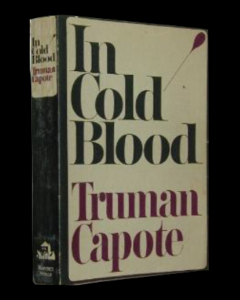
_____. The Dogs Bark (New York: Random House, 1973)
_____. Music for Chameleons (New York: Random House, 1981)
Caputo, Philip. A Rumor of War (New York: Holt, Rinehart and Winston, 1976)
Carr, David. The Night of the Gun: A Reporter Investigates the Darkest Story of His Life — His Own (New York: Simon and Schuster, 2008)
Carr, Erin Lee. All That You Leave Behind (New York: Ballantine, 2019)
Carroll, E. Jean. Hunter: The Strange and Savage Life of Hunter S. Thompson (New York: Dutton, 1993).
Caswell, Lucy Shelton, editor. Guide to Sources in American Journalism History (New York: Greenwood, 1989)
Cenziper, Debbie, with Jim Obergefell. Love Wins: The Lovers and Lawyers Who Fought the Landmark Case for Marriage Equality (New York: HarperCollins, 2016)
Clayton, Charles C. Fifty Years for Freedom: The Story of Sigma Delta Chi’s Service to American Journalism, 1909-1959 (Carbondale: Southern Illinois University Press, 1959)
Cleverly, Michael, and Bob Braudis. The Kitchen Readings (New York: HarperCollins, 2008)
Cloud, Stanley, and Lynne Olson. The Murrow Boys: Pioneers on the Front Lines of Broadcast Journalism (Boston: Houghton Mifflin, 1996)
Coates, Ta-Nehisi. Between the World and Me (New York: Spiegel and Grau, 2015)
Cohen, Bernard. The New York Graphic: The World’s Zaniest Newspaper (Philadelphia: Chilton Book Company, 1964)
Cohen, Elliot D. Philosophical Issues in Journalism (New York: Oxford University Press, 1992)

Cohen, Patricia Cline. The Murder of Helen Jewett (New York: Doubleday, 2010)
Collins, Paul. The Murder of the Century: The Gilded Age Crime That Scandalized a City and Started the Tabloid Wars (New York: Crown, 2011)
Connelly, Michael. Crime Beat: A Decade of Covering Cops and Killers (Boston: Little, Brown, 2006)
Conrad, Harold. Dear Muffo (New York: Stein and Day, 1982)
Cooke, Alistair, editor. The Vintage Mencken (New York: Vintage Books, 1955)
Cort, David. The Sin of Henry R. Luce (New York: Lyle Stuart, 1974)
Cramer, Richard Ben. What it Takes: The Way to the White House (New York: Random House, 1992)
Crist, Steve, and Laila Nabulsi, editors. Gonzo (Los Angeles: Ammo, 2006)
Cronkite, Walter. A Reporter’s Life (New York: Knopf, 1997)
Crouse, Timothy. The Boys on the Bus: Riding With the Campaign Press Corps (New York: Random House, 1973)
Cullen, Dave. Columbine (New York: Hachette, 2009)
_____. Parkland: Birth of a Movement (New York: Harper, 2019)
Denevi, Timothy. Freak Kingdom: Hunter S. Thompson’s Manic Ten-Year Crusade Against American Fascism (New York: Public Affairs, 2018)
DePastino, Todd. Bill Mauldin: A Life Up Front (New York: Norton, 2008)
Didion, Joan. Slouching Towards Bethlehem (New York: Simon and Schuster, 1968)
_____. The White Album (New York: Simon and Schuster, 1979)
_____. Salvador (New York: Simon and Schuster, 1983)
_____. Miami (New York: Simon and Schuster, 1987)
_____. After Henry (New York: Simon and Schuster, 1992),
_____. The Year of Magical Thinking (New York: Knopf, 2006)
Downie, Leonard, Jr. All About the Story: News, Power, Politics, and the Washington Post (New York: Public Affairs, 2020)
Draper, Robert. Rolling Stone: The Uncensored History (New York: Doubleday, 1990)
Drew, Elizabeth. Washington Journal: The Events of 1973-1974 (New York: Random House, 1974)
_____. Senator (New York: Simon and Schuster, 1979)
Dygert, James. The Investigative Journalist: Folk Heroes of a New Era (Englewood Cliffs, N.J.: Prentice-Hall, 1976)
Elliot, Osborn. The World of Oz (New York: Viking, 1980)
Emerson, Gloria. Winners and Losers: Battles, Retreats, Gains, Losses and Ruins from a Long War (New York: Random House, 1976)
Emery, Edwin, and Michael Emery. The Press and America: An Interpretive History of the Mass Media (Englewood Cliffs, N.J.: Prentice-Hall, 1988)
Ephron, Nora. Wallflower at the Orgy (New York: Viking, 1970)
_____. Crazy Salad: Some Things About Women (New York: Knopf, 1975)
_____. Scribble Scribble (New York: Knopf, 1978)
Epstein, Edward Jay. Between Fact and Fiction: The Problem of Journalism (New York: Random House, 1975)
Eszterhas, Joe. Charlie Simpson’s Apocalypse (New York: Random House, 1973)
_____. Nark! (San Francisco: Straight Arrow, 1974)
Faludi, Susan. Backlash: The Undeclared War Against American Women (New York: Crown Publishers, 1991)
Farrow, Ronan. Catch and Kill: Lies, Spies, and a Conspiracy to Protect Predators (New York: Little Brown, 2019)
Fast, Howard. Citizen Tom Paine (New York: Duell, Sloan and Pearce, 1943)
Fetcher, Charles A. Mencken: A Study of His Thought (New York: Knopf, 1978)
______,editor. The Diary of H. L. Mencken (New York: Knopf, 1989)
Finkel, David. The Good Soldiers (New York: Farrar, Straus and Giroux, 2009)
_____. Thank You for Your Service (New York: Farrar, Straus and Giroux, 2013)
Finkel, Michael. True Story: Murder, Memoir, Mea Culpa (New York: HarperCollins, 2005)
Flaherty, Francis. The Elements of Story: Field Notes on Nonfiction Writing (New York: Harper, 2009)
Folkerts, Jean, and Dwight Teeter, Jr. Voices of a Nation: A History of the Media in America (New York: Macmillan, 1989)
Frankel, Max. The Times of My Life and My Life with the Times (New York: Random House, 1999)
FitzGerald, Frances. A Fire in the Lake (Boston: Little, Brown, 1972)
Franklin, Benjamin. The Autobiography (New York: Vintage Books, 1992)
French, Thomas. Unanswered Cries: A True Story of Friends, Neighbors and Murder in a Small Town (New York: St. Martin’s, 1991)
_____. South of Heaven: Welcome to High School at the End of the 20th Century (New York: Doubleday, 1993)
_____. Zoo Story: Life in the Garden of Captives (New York: Hyperion, 2010)
_____, and Kelley Benham French. Juniper: The Story of the Girl Who Was Born Too Soon (New York: Little, Brown, 2016)
Friedrich, Otto. Decline and Fall: The Struggle for Power at a Great American Magazine (New York: Harper and Row, 1970)
Friendly, Fred W. Due to Circumstances Beyond Our Control (New York: Random House, 1967)
_____. The Good Guys, the Bad Guys and the First Amendment (New York: Random House, 1976)
_____. Minnesota Rag: The Dramatic Story of the Landmark Supreme Court Case that Gave New Meaning to Freedom of the Press (New York: Random House, 1981)
Gabler, Neal. Winchell: Gossip, Power and the Culture of Celebrity (New York: Knopf, 1994)
Gans, Herbert J. Deciding What’s News: A Study of CBS Evening News, NBC Nightly News, Newsweek and Time (New York: Pantheon, 1979)
Garrels, Anne. Naked in Baghdad: The Iraq War and the Aftermath as Seen by NPR’s Correspondent (New York: Farrar, Straus and Giroux, 2003)
Gates, Gary Paul. Air Time: The Inside Story of CBS News (New York: Harper and Row, 1978)
Germond, Jack, and Jules Witcover. Whose Broad Stripes and Bright Stars: The Trivial Pursuit of the Presidency (New York: Warner Books, 1989)
Gilger, Kristin Grady, and Julia Wallace. There’s No Crying in Newsrooms: What Women Have Learned about What It Takes to Lead (Lanham, Maryland: Roman and Littllefield, 2021)
Gill, Brendan. Here at The New Yorker (New York: Random House, 1975)
Gladwell, Malcolm. The Tipping Point (Boston: Little, Brown, 2000)
_____. Blink (Boston: Little, Brown, 2005)
_____. Outliers (Boston: Little, Brown, 2008)
_____. What the Dog Saw (Boston: Little, Brown, 2009)
Golden, Harry. The Right Time: The Autobiography (New York: Putnam, 1969)
Goldsmith, Barbara L. Little Gloria, Happy at Last (New York: Knopf, 1982)
Goldstein, Tom. The News at Any Cost: How Journalists Compromise their Ethics to Shape the News (New York: Simon and Schuster, 1985)
Good, Howard, editor. Journalism Ethics Goes to the Movies (Landham. Maryland: Rowman and Littlefield, 2008)
Goodman, Walter. The Committee: The Extraordinary Career of the House Committee on Un-American Activities (New York: Farrar, Straus and Giroux, 1968)
Gordon, Gregory, and Ronald E. Cohen. Down to the Wire: UPI’s Fight for Survival (New York: McGraw-Hill, 1990)
Gottlieb, Robert, and Irene Wolt. Thinking Big: The Story of the Los Angeles Times, its Publishers and Their Influence on Southern California (New York: Putnam, 1977)
Goulden, Joseph C. Fit to Print: A. M. Rosenthal and His Times (New York: Lyle Stuart, 1988)
Graham, Katherine. Personal History: A Memoir (New York: Knopf, 1997)
Grant, Richard. American Nomads: Travels with Lost Conquistadors, Mountain Men, Cowboys, Indians, Hoboes, Truckers, and Bullriders (New York: Grove, 2003)
Green, Ben. The Soldier of Fortune Murders: A True Story of Obsessive Love and Murder-for-Hire (New York: Delacorte Press, 1992)
Greene, Bob. Johnny Deadline: Reporter (Chicago: Nelson-Hall, 1975)
_____. American Beat (New York: Scribner, 1983)
_____. Late Edition: A Love Story (New York: St. Martin, 2009)
Greenlaw, Wayne. Fighting the Devil in Dixie: How Civil Rights Activists Took on the Ku Klux Klan in Alabama (Chicago: Chicago Review Press, 2011)
Greene, Melissa Faye. Praying for Sheetrock (Cambridge, Mass.: DaCapo Press, 1991)
Grisham, John. An Innocent Man: Murder and Injustice in a Small Town (New York: Doubleday, 2006)
Halberstam, David. The Best and the Brightest (New York: Random House, 1972)
_____. The Powers That Be (New York: Knopf, 1979)
Hamilton, Alexander, James Madison and John Jay. The Federalist (Garden City: Tudor, 1937)
Hamblin, Dora Jane. That Was the LIFE (New York: W.W. Norton, 1977)
Hainey, Michael. After Visiting Friends: A Son’s Story (New York: Scribner, 2014)
Hardin, Luke. The Snowden Files: The Inside Story of the World’s Most Wanted Man (New York: Vintage, 2014)
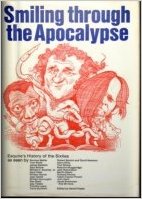 Hart, Jack. A Writer’s Coach: The Complete Guide to Writing Strategies That Work (New York: Anchor Press, 2007)
Hart, Jack. A Writer’s Coach: The Complete Guide to Writing Strategies That Work (New York: Anchor Press, 2007)
_____. Storycraft: The Complete Guide to Writing Narrative Nonfiction (Chicago: Chicago Guides to Writing, Editing, and Publishing, 2011)
Hayes, Harold, editor. Smiling through the Apocalypse: Esquire’s History of the Sixties (New York: McCall, 1970)
Hecht, Ben. A Child of the Century (New York: Dutton, 1985)
Heilemann, John, and Mark Halperin. Game Change: Obama and the Clintons, McCain and Palin, and the Race of a Lifetime (New York: Harper, 2010)
Hemingway, Ernest. Byline: Selected Articles and Dispatches of Four Decades (New York: Scribner, 1967)
Herr, Michael. Dispatches (New York: Knopf, 1978)
Hersh, Seymour. My Lai 4: A Report on the Massacre and its Aftermath (New York: Random House, 1970)
_____. The Price of Power: Kissinger in the Nixon White House (New York: Summit, 1983)
_____. The Dark Side of Camelot (Boston: Little, Brown, 1997)
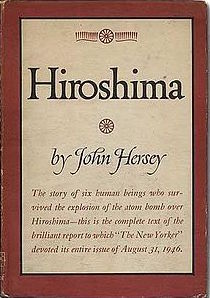
Hersey, John. Hiroshima (New York: Knopf, 1946)
Hertsgaard, Mark. On Bended Knee: The Press and the Reagan Presidency (New York: Farrar, Straus and Giroux, 1988)
Hiassen, Carl. Kick Ass: Selected Columns (Gainesville: University Press of Florida, 1999)
_____. Paradise Screwed: Selected Columns (Gainesville: University Press of Florida, 2009)
Hofstadter, Richard. The American Political Tradition (New York: Knopf, 1948)
_____. The Age of Reform (New York: Knopf, 1955)
Hohenberg, John. Foreign Correspondence: The Great Reporters and Their Times (New York: Columbia University Press, 1964)
_____. The Pulitzer Prizes: A History of the Awards (New York: Columbia University Press, 1974)
Hulteng, John, and Roy Paul Nelson. The Fourth Estate: An Informal Appraisal of the News and Opinion Media (New York: Harper and Row, 1983)
Ivins, Molly. Nothin’ But Good Times Ahead (New York: Random House, 1993)
_____. You Got to Dance with Them What Brung You: Politics in the Clinton Years (New York: Random House, 1998)
_____. Molly Ivins Can’t Say That, Can She? (New York: Random House, 2001)
Johnson, E.W. The New Journalism (Lawrence: The University of Kansas Press, 1971)
Johnson, Marilyn. The Dead Beat: Lost Souls, Lucky Stiffs, and the Perverse Pleasures of Obituaries (New York: Harper, 2007)
Junger, Sebastian. The Perfect Storm (New York: W.W. Norton, 1997)
_____. A Death in Belmont(New York: W.W. Norton, 1999)
_____. Fire (New York: W.W. Norton, 2001)
_____. War (New York: Twelve Books, 2010)
Kahn, E.J., Jr. The World of Swope: A Biography of Herbert Bayard Swope (New York: Simon and Schuster, 1965)
Kantor, Jodi and Megan Twohey. She Said: Breaking the Sexual Harassment Story That Helped Ignite a Movement (New York: Penguin Press, 2019)
_____. Chasing the Truth: A Young Journalist’s Guide to Investigative Reporting (New York: Philomel, 2021)
Kaplan, Justin. Lincoln Steffens: A Biography (New York: Simon and Schuster, 1974)
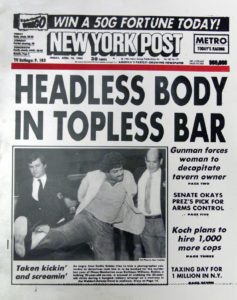
Kearns, Burt. Tabloid Baby: Out of the Babylon of Reality Television Rises a New Generation of Network News (New York: Celebrity Books, 1999)
Kennerly, David Hume. Shooter (New York: Newsweek Books, 1979)
Kerrane, Kevin, and Ben Yagoda. The Art of Fact: A Historical Anthology of Literary Journalism (New York: Simon and Schuster, 1998)
Kidder, Tracy. The Soul of a New Machine (Boston: Atlantic-Little,Brown, 1981)
King, Gilbert. The Execution of Willie Francis: Race, Murder and the Search for Justice in the American South (New York: Basic Books, 2008)
_____. Devil in the Grove: Thurgood Marshall, the Groveland Boys and the Dawn of a New America (New York: Harper, 2012)
_____. Beneath a Ruthless Sun: A True Story of Violence, Race, and Justice Lost and Found (New York: Riverhead Books, 2018)
Kluger, Richard. The Paper: The Life and Death of the New York Herald Tribune (New York: Knopf, 1986)
_____. Indelible Ink: The Trials of John Peter Zenger and the Birth of America’s Free Press (New York: W.W. Norton, 2016)
Kovach, Bill, and Tom Rosensteil. The Elements of Journalism: What Newspeople Should Know and the Public Should Expect (Revised and Updated) (New York: Three Rivers Press, 2014)
Kunkel, Thomas. Genius in Disguise: Harold Ross and the New Yorker (New York: Random House, 1995)
Krakauer, Jon. Into Thin Air (New York: Villard Books, 1997)
_____. Missoula: Rape and the Justice System in a College Town (New York: Doubleday, 2016)
Kroeger, Brooke. Undaunted: How Women Changed American Journalism (New York: Random House, 2023)
Kurkjian, Stephen. Master Thieves: The Boston Gangsters Who Pulled Off the World’s Greatest Art Heist (New York: Public Affairs, 2015)
Kurlansky, Mark. 1968: The Year That Rocked the World (New York: Ballantine, 2004)
Lankford, Gerald. The Richard Harding Davis Years: A Biography of a Mother and Son (New York: Holt, Rinehart and Winston, 1961)
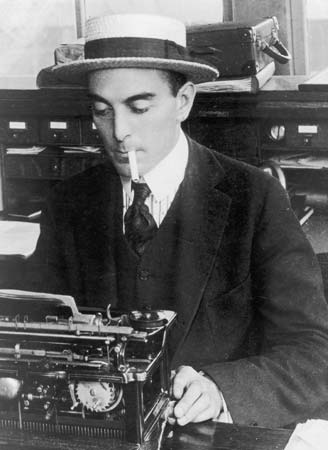
Lardner, Ring. How to Write Short Stories (With Some Samples) (New York: Scribner, 1926)
_____. Ring Around the Bases; The Complete Baseball Stories of Ring Lardner (New York: Scribner, 1992)
_____. Stories and Other Writings (New York: Library of America, 2013)
Lardner, Ring Jr. The Lardners: My Family Remembered (New York: Harper and Row, 1976)
LeDuff, Charlie. Work and Others Sins: Life in New York City and Thereabouts (New York: Penguin, 2004)
_____. Us Guys: The True and Twisted Story of the American Man (NewYork: Penguin, 2007)
Lehr, Dick. The Fence: A Police Cover-up Along Boston’s Racial Divide (New York: Harper, 2009)
_____. The Birth of a Nation: How a Legendary Filmmaker and a Crusading Editor Reignited America’s Civil War (New York: Public Affairs, 2014)
_____, and Gerard O’Neill. Underboss: The Rise and Fall of a Mafia Family (New York: St. Martin’s Press, 1989)
_____, and Gerard O’Neill. Black Mass: The Irish Mob, The FBI and A Devil’s Deal (New York: Public Affairs, 2000)
_____, and Mitchell Zuckoff. Judgment Ridge: The True Story Behind the Dartmouth Murders (New York: Harper, 2003)
_____, and Gerard O’Neill. Whitey: The Life of America’s Most Notorious Mob Boss (New York: Crown, 2013)
Lewis, Alfred Allan. Man of the World: Herbert Bayard Swope’s Charmed Life (Indianapolis: Bobbs-Merrill, 1978)
Leibling, A.J. The Press (New York: Pantheon, 1961)
Littlefield, Roy Everett III. William Randolph Hearst: His Role in American Progressivism (Lanham, Md.: The University Press of America, 1980)
Lubow, Arthur. The Reporter Who Would Be King: A Biography of Richard Harding Davis (New York: Scribners, 1992)

Lukas, J. Anthony. Common Ground: A Turbulent Decade in the Lives of Three American Families (New York: Knopf, 1985)
Love, Robert, editor. The Best of Rolling Stone (New York: Doubleday, 1993)
Lyon, Peter. Success Story: The Life and Times of S.S. McClure (New York:Scribner,1963)
Mailer, Norman. The Armies of the Night (New York: New American Library, 1968)
_____. The Fight (Boston: Little, Brown, 1977)
_____. The Executioner’s Song (Boston: Little, Brown, 1979)
Malcolm, Janet. The Journalist and the Murderer (New York: Knopf, 1990)
Mallon, Thomas. Rockets and Rodeos and Other American Spectacles (New York: Ticknor and Fields, 1993)
Manchester, William. Controversy and Other Essays in Journalism, 1950-1975 (Boston: Little, Brown, 1976)
Mankiewicz, Frank. Perfectly Clear: Nixon from Whittier to Watergate (New York: Quadrangle, 1973)
Marinovich, Greg. Murder at Small Koppie: The Real Story of the Marikana Massacre (New York: Penguin, 2016)
_____, and Joao Silva. The Bang-Bang Club: Snapshots from a Hidden War (New York: Basic Books, 2001)
Maynard, Joyce. Looking Back: A Chronicle of Growing Up in the Sixties (New York: Doubleday, 1973)
____. To Die For: A Novel (New York: Dutton, 1992)
_____. At Home in the World: A Memoir (New York: Picador, 1998)
Mayer, Jane, and Doyle McManus. Landslide: The Unmaking of the President, 1984-1988 (Boston: Houghton Mifflin, 1988)
McGinnis, Joe. The Selling of the President (New York: Trident Press, 1969)
_____. Going to Extremes (New York: Knopf, 1980)
_____. Fatal Vision (New York: Putnam, 1983)
_____. Blind Faith (New York: Putnam, 1989)
_____. Cruel Doubt (New York: Simon and Schuster, 1991).
McKeen, William. Hunter S. Thompson (Boston: Twayne, 1991)
_____. Tom Wolfe (New York: Twayne, 1995)
_____. Outlaw Journalist: The Life and Times of Hunter S. Thompson (New York: W.W. Norton, 2008
_____, and Jean Chance, editors. Literary Journalism: A Reader (San Francisco: Wadsworth, 2000)
McPhee, John. Oranges (New York: Farrar, Straus and Giroux, 1967)
_____. Levels of the Game (New York: Farrar, Straus and Giroux, 1969)
_____. Encounters with the Archdruid (New York: Farrar, Straus and Giroux,1971)
_____. The Deltoid Pumpkin Seed (New York: Farrar, Straus and Giroux, 1973)
_____. Coming into the Country (New York: Farrar, Straus and Giroux, 1978)
_____. The John McPhee Reader (New York: Farrar, Straus and Giroux, 1978)
_____. Giving Good Weight (New York: Farrar, Straus and Giroux, 1980)
_____. Table of Contents (New York: Farrar, Straus and Giroux, 1985)
_____. The Second John McPhee Reader (New York: Farrar, Straus and Giroux, 1996)
McWilliams, Carey. The Education of Carey McWilliams (New York: Simon and Schuster, 1979)
Mehren, Elizabeth. Born Too Soon (New York: Doubleday, 1991)
_____. After the Darkest Hour the Sun Will Shine Again: A Parent’s Guide to Coping with the Loss of a Child (New York: Touchstone, 1997)
Mencken, H.L. Newspaper Days (New York: Knopf, 1940)
_____. Prejudices: A Selection (New York: Vintage Books, 1955)
_____. A Choice of Days (New York: Knopf, 1980)
Metz, Robert. CBS: Reflections in a Bloodshot Eye (Chicago: Playboy Press, 1975)
Miller, Henry. The Air-Conditioned Nightmare (New York: New Directions, 1945)
Miller, Lee G. The Story of Ernie Pyle (New York: Viking, 1950)
Mitchell, Joseph. Up in the Old Hotel (New York: Rantheon, 1991)
Mitford, Jessica. Poison Penmanship: The Gentle Art of Muckraking (New York: Knopf, 1979)
Mnookin, Seth. Hard News: Twenty-one Brutal Months at The New York Times and How They Changed the American Media (New York: Random House, 2004)
Moon, William Least Heat. Blue Highways: A Journey into America (Boston: Little, Brown, 1981)
Morris, Joe Alex. Deadline Every Minute: The Story of the United Press (New York: Doubleday, 1957)
Morris, Willie. Yazoo: Integration in a Deep Southern Town (New York: Harper’s Magazine Press, 1971)
_____. The Courting of Marcus Dupree (New York: Doubleday, 1983)
_____. New York Days (Boston: Little, Brown, 1993)
Morton, Paul E. Tabloid Valley: Supermarket News and America Culture (Gainesville: University Press of Florida, 2009)
Nagourney, Adam. The Times: How the Newspaper of Record Survived Scandal, Scorn, and the Transformation of Journalism (New York: Crown Publisher, 2023)
Nasaw, David. The Chief: The Life of William Randolph Hearst (New York: Mariner Books, 2001)
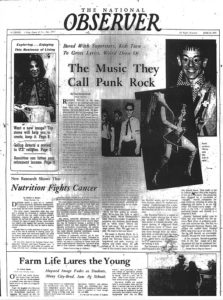
National Observer editors. The Observer’s World: People, Places, and Events fromthe Pages of The National Observer (Princeton, N.J.: Princeton UniversityPress, 1965).
Navasky, Victor S. Naming Names (New York: Viking, 1980)
New Yorker editors. The New Yorker Book of War Pieces (New York: Reynal andHitchcock, 1947)
Niedzviecki, Hal. The Peep Diaries: How We’re Learning to Love Watching Ourselvesand Our Neighbors (San Francisco: City Lights, 2009)
Okrent, Daniel. Last Call: The Rise and Fall of Prohibition (New York: Scribner, 2010)
Orlean, Susan. Saturday Night (New York: Knopf, 1990)
_____. The Orchid Thief: A True Story of Beauty and Obsession (New York: Ballantine, 2000)
_____. The Bullfighter Checks Her Makeup (New York: Random House, 2001)
O’Rourke, P.J. Holidays in Hell (Boston: Atlantic Monthly Press, 1988)
_____. Modern Manners (Boston: Atlantic Monthly Press, 1989)
_____. All the Trouble in the World (Boston: Atlantic Monthly Press, 1994)
Paine, Thomas. Collected Writings: Common Sense / The Crisis / Rights of Man / The Age of Reason (New York: Library of America, 1995)
Parenti, Michael. Inventing Reality: The Politics of the Mass Media (New York: St. Martin, 1986)
Patner, Andrew. I.F. Stone: A Portrait (New York: Pantheon, 1988)
Pelley, Scott. Truth Worth Telling: A Reporter’s Search for Meaning in the Stories of Our Times (New York: Hanover Square Press, 2019)
Penenberg, Adam L. Tragic Indifference: One Man’s Battle with the Auto Industryover the Dangers of SUVS (New York: HarperCollins, 2003)
____. Viral Loop: From Facebook to Twitter, How Today’s Smartest Businesses GrowThemselves (New York: Hyperion, 2009)
Perry, Charles, editor. Smokestack El-Ropo’s Bedside Reader (San Francisco:Straight Arrow, 1972)
_____. The Haight Ashbury (New York: Random House, 1984)
Perry, Paul. (New Haven: Yale University Press, 2013
Fear and Loathing: The Strange and Terrible Saga of Hunter S. Thompson (New York: Thunder’s Mouth, 1993)
Pettegree, Andrew. The Invention of News: How the World Came to Know About Itself (New Haven: Yale University Press, 2013)
Pickett, Calder M. Voices of the Past: Key Documents in the History of American Journalism (Columbus, Ohio: Grid, 1977)
Plimpton, George. Paper Lion (New York: Simon and Schuster, 1966)
_____. Shadow Box (New York: Putnam, 1977)
_____. The Best of Plimpton (New York: Atlantic Monthly Press, 1991)
_____. Truman Capote : In Which Various Friends, Enemies, Acquaintances, and DetractorsRecall His Turbulent Career (New York: Doubleday, 1997
Pollack, Richard, editor. Stop the Presses, I Want to Get Off ! (New York: Random House, 1975)
Pyle, Ernie. Here is Your War (New York: Henry Holt, 1943)
_____. Brave Men (New York: Henry Holt, 1944)
Raines, Howell. My Soul is Rested: Movement Days in the Deep South Remembered (New York: Putnam, 1977)
Rammelkamp, Julian. Pulitzer’s Post Dispatch, 1878-1883 (Princeton, N.J.: Princeton University Press, 1967)
Rather, Dan, and Mickey Hershkowitz. The Camera Never Blinks: Adventures of a TV Journalist (New York: William Morrow, 1977)
Reasoner, Harry. Before the Colors Fade (New York: Knopf, 1981)
Reeves, Richard. American Journey: Traveling With Tocqueville in Search of Democracy in America (New York: Simon and Schuster, 1982)
Remnick, David. King of the World: Muhammad Ali and the Rise of an American Hero (New York: Random House, 1998)
_____. Reporting: Writings from The New Yorker (New York: Knopf, 2006)
_____. The Bridge: The Life and Rise of Barack Obama (New York: Picador, 2010)
Reston, James. The Artillery of the Press: Its Influence on American Foreign Policy (New York: Harper and Row, 1967)
Rhodes, Richard. The Making of the Atomic Bomb (New York: Simon andSchuster, 1987)
_____ Farm: A Year in the Life of an American Farmer (New York: Simon and Schuster, 1989)
_____. A Hole in the World: An American Boyhood (New York: Simon and Schuster,1990)
_____. Dark Sun: The Making of the Hydrogen Bomb (New York: Simon and Schuster, 2005)
_____. Arsenals of Folly (New York: Knopf, 2007)
Rich, Frank. Hot Seat: Theater Criticism for The New York Times, 1980-1993 (New York: Random House, 1998)
_____. The Greatest Story Ever Sold: The Decline and Fall of Truth in Bush’s America (New York: Penguin, 2006)
Riis, Jacob A. How the Other Half Lives (New York: Scribner, 1890)
Roberts, Chalmers M. The Washington Post: The First 100 Years (Boston: Houghton Mifflin, 1977)
Roberts, Gene, and Hank Klibanoff. The Race Beat (New York: Knopf, 2006).
Ross, Lillian. Picture (New York: Rinehart, 1952)
_____. Portrait of Hemingway (New York: Simon and Schuster, 1961)
_____. Reporting (New York: Dodd, Mead, 1964)
_____. Talk Stories (New York: Simon and Schuster, 1965)
_____. Moments with Chaplin (New York: Dodd, Mead, 1980)
_____. Takes (New York: Congdon & Weed, 1983)
_____. Here But Not Here (New York: Random House, 1998)
Rovere, Richard H. Senator Joe McCarthy (Cleveland: World, 1959)
Sabbag, Robert. Snowblind: A Brief Career in the Cocaine Trade (Indianapolis : Bobbs-Merrill, 1976)
Sack, John. M (New York: New American Library, 1967)
Sager, Mike. Scary Monsters and Super Freaks: Stories of Sex, Drugs, Rock’n’Roll and Murder (New York: Thunder’s Mouth, 2003)
Scanlon, Paul, editor. Reporting: The Rolling Stone Style (New York: Doubleday,1977)
Scharff, Edward E. Worldly Power: The Making of The Wall Street Journal (NewYork: Beaufort, 1986)
Shorr, Daniel. Clearing the Air (Boston: Houghton Mifflin, 1977)
Scura, Dorothy, editor. Conversations with Tom Wolfe (Jackson: University Press of Mississippi, 1990)
Seife, Charles. Zero:The Biography of a Dangerous Idea (New York: Viking, 2000)
_____. Alpha and Omega: The Search for the Beginning and End of the Universe (NewYork: Viking, 2003)
Seldes, George. Witness to a Century: Encounters with the Noted, the Notorious andThree SOBs (New York: Ballantine, 1987)
Shilts, Randy. And the Band Played On: Politics, People and the AIDS Epidemic (NewYork: St. Martin, 1987)
Sims, Norman, editor. The Literary Journalists: The New Art of Personal Reportage (New York: Ballantine, 1984)
Southern, Terry. Red Dirt Marijuana and Other Tastes (New York: New American Library, 1967)
_____. Now Dig This (New York: Grove, 2001)
Spivak, Lawrence E., and Charles Angoff, editors. The American Mercury Reader (New York: Blakiston, 1944)
Stone, I.F. The Trial of Socrates (Boston: Little,Brown,1989)
Rivers, William L., and Wilbur Schramm. Responsibility in Mass Communication (New York: Harper and Row, 1969)
Shawcross, William. Sideshow: Kissinger, Nixon and the Destruction of Cambodia (New York: Simon and Schuster, 1981)
Shell, Ellen Ruppel. A Child’s Place: A Year in the Life of a Day Care Center (Boston: Little, Brown, 1998)
_____. The Hungry Gene: The Inside Story of the Obesity Industry (Boston: Atlantic Monthly Press, 2009)
_____. Cheap: The High Cost of Discount Culture (New York: Penguin, 2009)
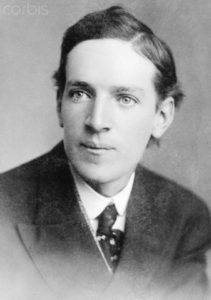
Sinclair, Upton. The Jungle (New York: Doubleday, 1906)
Sloan, William David. Pulitzer Prize Editorials: America’s Best Editioral Writing, 1917-1979 (Ames: The Iowa State University Press, 1980)
_____, editor. American Journalism History: An Annotated Bibliography (New York:Greenwood, 1989)
_____, and James G. Stovall, editors. The Media in America (Worthington,Ohio: Publishing Horizons, 1989)
Small, William J. Political Power and the Press (New York: W. W. Norton, 1972)
Smiley, Nixon. Knights of the Fourth Estate: The Story of the Miami Herald (Miami:E.A. Seamann, 1974)
Smith, Dennis. Report from Ground Zero (New York: Penguin, 2002)
Snyder, Louis L., and Richard B. Morris, editors. A Treasury of Great Reporting (New York: Simon and Schuster, 1962)
Sokolov, Raymond. Wayward Reporter: The Life of A.J. Liebling (San Francisco: Donald Ellis, 1980)
Sperber, A.M. Murrow: His Life and Times (New York: Freundlich, 1986)
Stallman, R.W., and E.R. Hagemann, editors. The War Dispatches of Stephen Crane (New York: New York University Press, 1964)
Starr, Douglas. Blood: An Epic History of Medicine and Commerce (New York: Knopf, 19978)
_____. The Killer of Little Shepherds: A True Crime Story and the Birth of Forensic Science (New York: Knopf, 2010)
Steel, Ronald. Walter Lippmann and the American Century (Boston: Little, Brown,1980)
Steffens, Lincoln. The Autobiography of Lincoln Steffens (New York: Harcourt, Brace and Company, 1931)
Stenerson, David. H.L. Mencken: Iconoclast From Baltimore (Chicago: The Universityof Chicago Press, 1971)
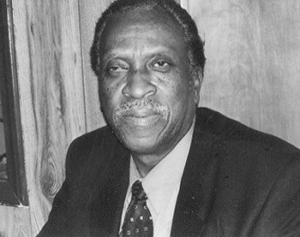
Suggs, Henry Lewis. The Black Press in the South (Westport, Conn.: Greenwood,1983)
_____. P.B. Young, Newspaperman: Race, Politics, and Journalism in the New South,1910-1962 (Charlottesville: The University of Virginia Press, 1988)
Swanberg, W.A. Citizen Hearst (New York: Scribner, 1964)
_____. Pulitzer (New York: Scribner, 1967)
_____. Luce and His Empire (New York: Scribner, 1972)
Taddeo, Lisa. Three Women (New York: Avid Reader Press, 2019)
Taibbi, Matt. Spanking the Donkey: Dispatches from the Dumb Season (New York:The New Press, 2005)
Talese, Gay. The Kingdom and the Power (New York: World, 1969)
_____. Fame and Obscurity (New York: Doubleday, 1970)
_____. Honor Thy Father (New York: New American Library, 1971)
_____.Thy Neighbor’s Wife (New York: Doubleday, 1979)
_____. Unto the Sons (New York: Knopf, 1991)
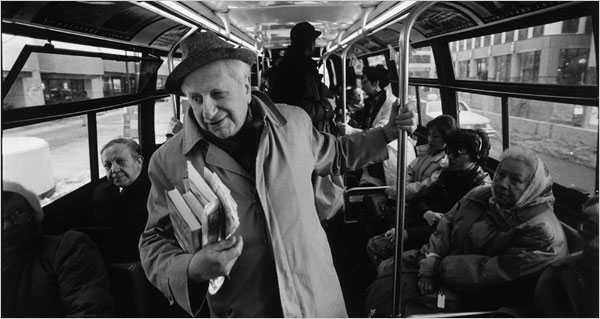
Terkel, Studs. Hard Times: An Oral History of the Great Depression (New York: Pantheon, 1970)
_____. Division Street: America (New York: Pantheon, 1972)
_____. Working: People Talk About What they Do All Day and How They Feel AboutWhat they Do (New York: Pantheon, 1974)
_____. American Dreams: Lost and Found (New York: Pantheon, 1980)
Tebbel, John, and Sarah Miles Watts. The Press and the Presidency (New York: Oxford University Press, 1985)
Thompson, Hunter S. Hell’s Angels (New York: Random House, 1967).
_____. Fear and Loathing in Las Vegas (New York: Random House, 1971)
_____. Fear and Loathing: On the Campaign Trail ’72 (San Francisco: StraightArrow, 1973)
_____. The Great Shark Hunt (New York: Summit, 1979)
_____.The Curse of Lono (New York: Bantam, 1983)
_____. Generation of Swine (NewYork: Summit, 1988)
_____. Songs of the Doomed (New York: Summit, 1990)
_____. The Proud Highway (New York: Villard Books, 1997)
_____. The Rum Diary (New York: Simon and Schuster, 1998)
_____. Fear and Loathing in America (New York: Simon and Schuster, 2000)
_____. Kingdom of Fear (New York: Simon and Schuster, 2003)
_____. Hey Rube (New York: Simon and Schuster, 2004)
_____. Fear and Loathing at Rolling Stone (New York: Simon and Schuster, 2014)
Thompson, Toby. The 60s Report (New York: Rawson Wade, 1979)
Thompson, W. Fletcher, Jr. The Image of War: The Pictorial Reporting of the American Civil War (New York: Thomas Yoseloff, 1959)
Thurber, James. The Years With Ross (New York: Little, Brown, 1960)
Tifft, Susan and Alex S. Jones. The Trust: The Private and Powerful Behind the New York Times (Boston: Little, Brown, 1999)
Toobin, Jeffrey. The Run of His Life: The People v. O. J. Simpson (New York: Random House, 1996)
____. American Heiress: The Wild Saga of the Kidnapping, Crimes and Trial of Patty Hearst (New York: Doubleday, 2016)
Torgoff, Martin. Can’t Find My Way Home: America in the Great Stoned Age (NewYork: Simon and Schuster, 2004)
Torrey, Beef, and Kevin Simonson, editors. Conversations with Hunter S. Thompson (Jackson: University Press of Mississippi, 2008)
Treglown, Jeremy. Mr. Straight Arrow: The Career of John Hersey, Author of Hiroshima (New York: Farrar, Straus and Giroux, 2019)
Tur, Katie. Unbelievable: My Front-Row Seat to the Craziest Campaign in American History (New York: William Morrow, 2017)
Ureneck, Lou. The Great Fire: One American’s Mission to Rescue Victims of the 20th Century’s First Genocide (New York: Harper, 2015)
Waldrop, Frank C. McCormick of Chicago: An Unconventional Portrait of a Controversial Figure(Englewood Cliffs, N.J.: Prentice-Hall, 1966)
Walters, Barbara. Audition (New York: Random House, 2008)
Ward, Clarissa. On All Fronts: The Education of a Journalist (New York: Penguin Press, 2020)
Washington, Ray. Cracker Florida: Some Lives and Times (Miami: Banyan, 1983)
Watts, Steve. Mr. Playboy: Hugh Hefner and the American Dream (New York: Wiley, 2008)
Wambaugh, Joseph. The Onion Field (New York: Delacorte, 1973)
Weinberg, Arthur, and Lila Weinberg. The Muckrakers: The Era in JournalismThat Moved America to Reform (New York: Capricorn, 1964)
Weinberg, Steve. Taking on the Trust: The Epic Battle of Ida Tarbell and John D.Rockefeller (New York: W.W. Norton, 2008)
Weingarten, Marc. The Gang that Wouldn’t Write Straight (New York: Crown, 2005)
Weisberger, Bernard. Reporters for the Union (Boston: Little, Brown, 1953)
Wenner, Jann, and Corey Seymour. Gonzo: An Oral Biography of Hunter S. Thompson (Boston: Little, Brown, 2007)
Whittemore, Hank. CNN: The Inside Story (Boston: Little, Brown, 1990)
Wicker ,Tom. On Press: A Life in Journalism (New York: Viking, 1980)
Winner, Isaiah. The Man Time Forgot: A Tale of Genius, Betrayal and the Creation of Time Magazine (New York: HarperCollins, 2006)
Witcover, Jules. Marathon: The Pursuit of the Presidency, 1972-1976 (New York:Viking, 1977)
Wolfe, Tom. The Kandy-KoloredTangerine-Flake Streamline Baby (New York: Farrar, Straus and Giroux, 1965)
_____. The Pump House Gang (New York: Farrar, Straus and Giroux, 1968)
_____. The Electric Kool-Aid Acid Test (New York: Farrar, Straus and Giroux, 1968)
_____. Radical Chic and Mau-Mauing the Flak Catchers (New York: Farrar, Straus and Giroux, 1971)
_____. The Right Stuff (New York: Farrar, Straus and Giroux, 1979)
_____. The Bonfire of the Vanities (New York: Farrar, Straus and Giroux, 1987)
_____. Hooking Up (New York: Farrar, Straus and Giroux, 2000).
_____. The Kingdom of Speech (New York: Little Brown, 2016)
_____, and E.W. Johnson, editors. The New Journalism (New York: Harperand Row, 1973)
Woodward, Bob, and Carl Bernstein. The Final Days (New York: Simon andSchuster, 1976)
Woodward, Bob, and Scott Armstrong. The Brethren (New York: Simon andSchuster, 1981)
Yardley, Jonathan. Ring: A Biography (New York: Random House, 1977)
Zuckoff, Mitchell. Choosing Naia: A Family’s Journey (Boston: Beacon, 2002)
_____. Ponzi’s Scheme: The True Story of a Financial Legend (New York: Random House, 2005)
_____. Lost in Shangri-La: A True Story of Survival, Adventure, and the Most Incredible Rescue Mission of World War II (New York: Harper, 2011)
_____. 13 Hours: The Explosive True Story of How Six Men Fought a Terror Attack and Repelled Enemy Forces (New York: Twelve Books, 2014)
_____. Fall and Rise: The Story of 9/11 (New York: Harper, 2019)
_____, and Dick Lehr. Judgment Ridge: The True Story Behind the Dartmouth Murders (New York: Harper, 2003)
